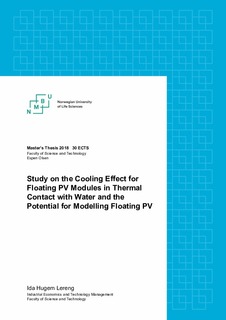| dc.contributor.advisor | Olsen, Espen | |
| dc.contributor.advisor | Selj, Josefine Helene | |
| dc.contributor.author | Lereng, Ida Hugem | |
| dc.date.accessioned | 2018-09-11T10:42:27Z | |
| dc.date.available | 2018-09-11T10:42:27Z | |
| dc.date.issued | 2018 | |
| dc.identifier.uri | http://hdl.handle.net/11250/2561972 | |
| dc.description.abstract | Floating solar power has become an increasingly popular technology, mainly because it does not occupy land areas and because lower operational temperatures lead to higher power outputs. With 75 % of the world’s surface consisting of water and a demand for more renewable energy production, the potential for solar PV increases significantly.
The purpose of this study is to quantify the cooling effect for a floating PV module in thermal contact with water. The cooling effect is estimated through analysis of experimental data from a test site at IFE, where the temperatures and power output of a floating module is measured. The data from the floating module is compared to measured data from a reference module. Additionally, a thermal model has been developed, aimed at estimating the temperature and power output for a floating module. Simulation software programs, PVsyst and TRNSYS, were also evaluated in terms of their ability to simulate floating PV modules. | nb_NO |
| dc.description.abstract | Flytende solenergi er en teknologi som stadig blir mer populær, hovedsakelig fordi flytende installasjoner ikke krever landareal, samt fordi lavere driftstemperaturer fører til høyere effekt. Ettersom 75 % av verdens overflate består av vann og behovet for fornybar energi øker, øker dermed også potensialet for solenergi.
Formålet med denne oppgaven er å kvantifisere kjøleeffekten til en flytende solcellemodul i termisk kontakt med vann. Kjøleeffekten estimeres ved analyse av eksperimentell data fra et testanlegg på IFE, hvor modulens temperatur og effekt måles. Dataene sammenlignes også med målte data fra en referansemodul. I tillegg har en termisk modell blitt utviklet for å estimere temperatur og effekt for flytende moduler. Simuleringsprogrammene PVsyst og TRNSYS ble brukt for å modellere flytende PV, og deres evne til dette ble så evaluert. | nb_NO |
| dc.language.iso | eng | nb_NO |
| dc.publisher | Norwegian University of Life Sciences, Ås | nb_NO |
| dc.rights | Attribution-NonCommercial-NoDerivatives 4.0 Internasjonal | * |
| dc.rights.uri | http://creativecommons.org/licenses/by-nc-nd/4.0/deed.no | * |
| dc.subject | PVsyst | nb_NO |
| dc.subject | TRNSYS | nb_NO |
| dc.subject | Solar energy | nb_NO |
| dc.title | Study on the cooling effect for floating PV modules in thermal contact with water and the potential for modeling floating PV | nb_NO |
| dc.type | Master thesis | nb_NO |
| dc.description.version | submittedVersion | nb_NO |
| dc.subject.nsi | VDP::Teknologi: 500 | nb_NO |
| dc.subject.nsi | VDP::Matematikk og Naturvitenskap: 400::Fysikk: 430 | nb_NO |
| dc.source.pagenumber | 90 | nb_NO |
| dc.description.localcode | M-IØ | nb_NO |

